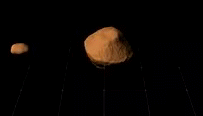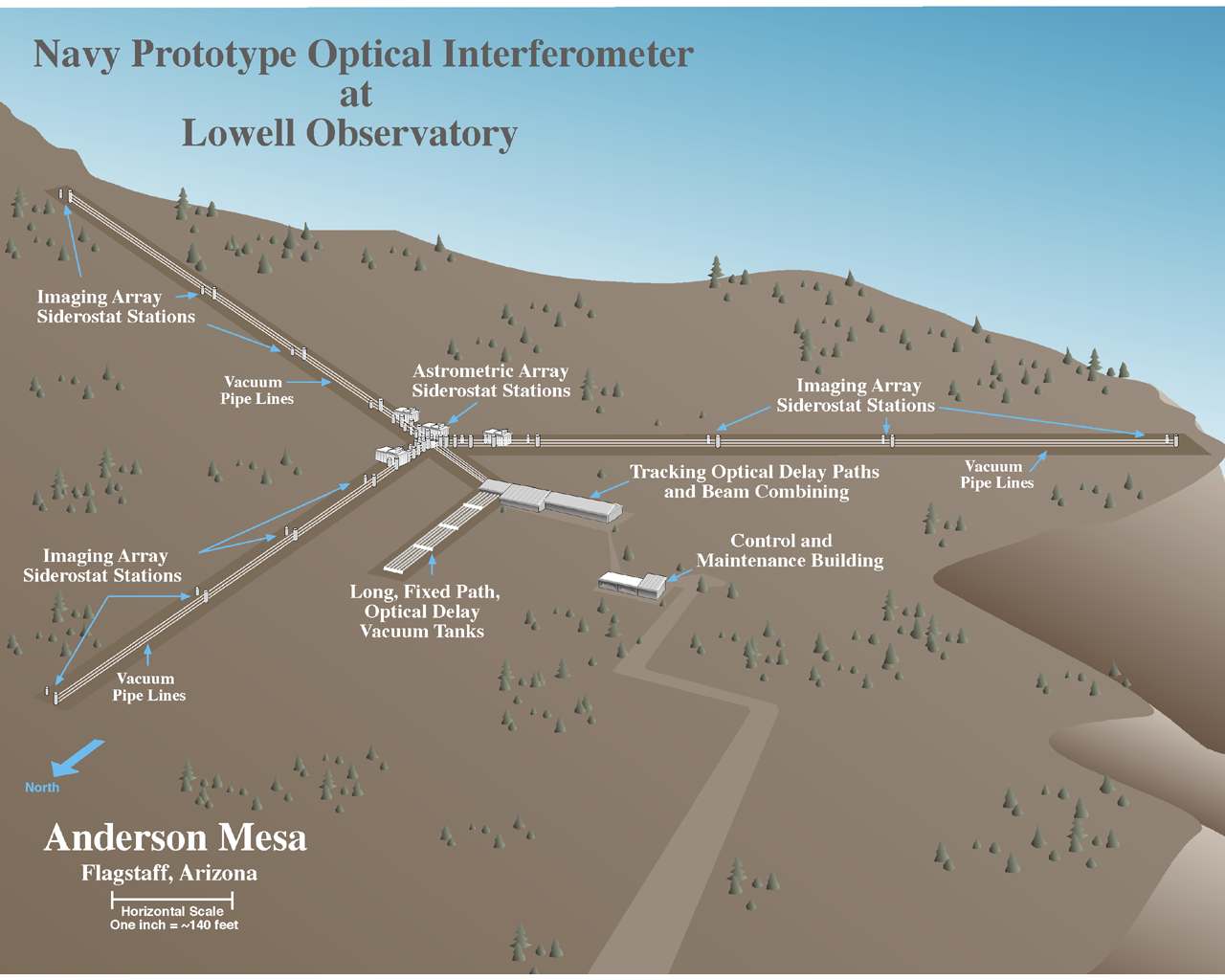|
Anderson Mesa Station
Anderson Mesa Station is an astronomical observatory established in 1959 as a dark-sky observing site for Lowell Observatory. It is located at Anderson Mesa in Coconino County, Arizona, about 12 miles southeast of Lowell's main campus on Mars Hill in Flagstaff, Arizona. Telescopes Current telescopes * The Perkins Telescope is shared with Boston University (BU) and Georgia State University. Built in 1931 by Warner & Swasey Company, it was originally located at the Perkins Observatory of Ohio Wesleyan University (OWU) in Delaware, Ohio. It was moved to Anderson Mesa in 1961, and was purchased by Lowell in 1998. Lowell and BU formed a partnership to operate the telescope that year, and GSU joined later. The original 69-inch mirror, which was figured by J. W. Fecker, Inc., was the largest single piece of glass ever cast in America when it was poured. It was replaced in 1965 with the current mirror made of Duran-50 low-expansion glass. * The John Hall Telescope was built by ... [...More Info...] [...Related Items...] OR: [Wikipedia] [Google] [Baidu] |
Lowell Observatory
Lowell Observatory is an astronomical observatory in Flagstaff, Arizona, United States. Lowell Observatory was established in 1894, placing it among the oldest observatories in the United States, and was designated a National Historic Landmark in 1965. and In 2011, the Observatory was named one of "The World's 100 Most Important Places" by Time Magazine. It was at the Lowell Observatory that the dwarf planet Pluto was discovered in 1930 by Clyde Tombaugh. The observatory was founded by astronomer Percival Lowell of Boston's Lowell family and is overseen by a sole trustee, a position historically handed down through the family. The first trustee was Lowell's third cousin Guy Lowell (1916–1927). Percival's nephew Roger Putnam served from 1927 to 1967, followed by Roger's son Michael (1967–1987), Michael's brother William Lowell Putnam III (1987–2013), and current trustee W. Lowell Putnam. Multiple astronauts attended the Lowell Observatory in 1963 while the moon was being ... [...More Info...] [...Related Items...] OR: [Wikipedia] [Google] [Baidu] |
Perkins Observatory
Perkins Observatory is an astronomical observatory in Delaware, Ohio. It is owned and operated by Ohio Wesleyan University. In 1931 it had the third largest telescope in the World; the 69 inch aperture Perkins telescope came online at this observatory. The mirror was the largest cast in the United States up to that time, and it was made by the United States National Bureau of Standards. In the 1930s this observatory also started periodic document release called '' The Telescope,'' featuring results from the telescope but grew to include other astronomical information. The University partnered with Ohio State University in 1935, to help run the big telescope and the agreement lasted for almost seven decades. In the 1960s the telescope was moved to Arizona, USA for better viewing conditions, and fitted with new larger mirror. Nevertheless, the Observatory continued to be a hub of astronomical activity in the region and for the University. In the 21st century the Observatory suppo ... [...More Info...] [...Related Items...] OR: [Wikipedia] [Google] [Baidu] |
Near-earth Object
A near-Earth object (NEO) is any small Solar System body whose orbit brings it into proximity with Earth. By convention, a Solar System body is a NEO if its closest approach to the Sun (perihelion) is less than 1.3 astronomical units (AU). If a NEO's orbit crosses the Earth's orbit, and the object is larger than across, it is considered a potentially hazardous object (PHO). Most known PHOs and NEOs are asteroids, but a small fraction are comets. There are over 30,503 known near-Earth asteroids (NEAs) and over a hundred known short-period near-Earth comets (NECs). A number of solar-orbiting meteoroids were large enough to be tracked in space before striking the Earth. It is now widely accepted that collisions in the past have had a significant role in shaping the geological and biological history of the Earth. Asteroids as small as in diameter can cause significant damage to the local environment and human populations. Larger asteroids penetrate the atmosphere to the surf ... [...More Info...] [...Related Items...] OR: [Wikipedia] [Google] [Baidu] |
Asteroid
An asteroid is a minor planet of the inner Solar System. Sizes and shapes of asteroids vary significantly, ranging from 1-meter rocks to a dwarf planet almost 1000 km in diameter; they are rocky, metallic or icy bodies with no atmosphere. Of the roughly one million known asteroids the greatest number are located between the orbits of Mars and Jupiter, approximately 2 to 4 AU from the Sun, in the main asteroid belt. Asteroids are generally classified to be of three types: C-type, M-type, and S-type. These were named after and are generally identified with carbonaceous, metallic, and silicaceous compositions, respectively. The size of asteroids varies greatly; the largest, Ceres, is almost across and qualifies as a dwarf planet. The total mass of all the asteroids combined is only 3% that of Earth's Moon. The majority of main belt asteroids follow slightly elliptical, stable orbits, revolving in the same direction as the Earth and taking from three to six years to comple ... [...More Info...] [...Related Items...] OR: [Wikipedia] [Google] [Baidu] |
Schmidt Camera
A Schmidt camera, also referred to as the Schmidt telescope, is a catadioptric astrophotographic telescope designed to provide wide fields of view with limited aberrations. The design was invented by Bernhard Schmidt in 1930. Some notable examples are the Samuel Oschin telescope (formerly Palomar Schmidt), the UK Schmidt Telescope and the ESO Schmidt; these provided the major source of all-sky photographic imaging from 1950 until 2000, when electronic detectors took over. A recent example is the Kepler space telescope exoplanet finder. Other related designs are the Wright camera and Lurie–Houghton telescope. Invention and design The Schmidt camera was invented by German–Estonian optician Bernhard Schmidt in 1930. Its optical components are an easy-to-make spherical primary mirror, and an aspherical correcting lens, known as a Schmidt corrector plate, located at the center of curvature of the primary mirror. The film or other detector is placed inside the camera, at the ... [...More Info...] [...Related Items...] OR: [Wikipedia] [Google] [Baidu] |
Lowell Observatory Near-Earth-Object Search
Lowell Observatory Near-Earth-Object Search (LONEOS) was a project designed to discover asteroids and comets that orbit near the Earth. The project, funded by NASA, was directed by astronomer Ted Bowell of Lowell Observatory in Flagstaff, Arizona. The LONEOS project began in 1993 and ran until the end of February 2008. Hardware LONEOS, in its final configuration, used a 0.6-meter f/1.8 Schmidt telescope, acquired from Ohio Wesleyan University in 1990, and a Lowell-built 16 megapixel CCD detector. This combination of instruments provided a field of view of 2.88 by 2.88 degrees (8.3 square degrees). It had a maximum nightly scan area of about 1,000 square degrees (covered four times). The instrument could cover the entire accessible dark sky in about a month. The CCD has detected asteroids as faint as visual magnitude 19.8 but its typical limiting visual magnitude was 19.3. The instrument is located at Lowell Observatory's dark sky site, Anderson Mesa Station, near Flagstaff, ... [...More Info...] [...Related Items...] OR: [Wikipedia] [Google] [Baidu] |
United States Naval Observatory Flagstaff Station
The United States Naval Observatory Flagstaff Station (NOFS), is an astronomical observatory near Flagstaff, Arizona, US. It is the national dark-sky observing facility under the United States Naval Observatory (USNO). NOFS and USNO combine as the Celestial Reference Frame manager for the U.S. Secretary of Defense. General information The Flagstaff Station is a command which was established by USNO (due to a century of eventually untenable light encroachment in Washington, D.C.) at a site west of Flagstaff, Arizona in 1955, and has positions for primarily operational scientists (astronomers and astrophysicists), optical and mechanical engineers, and support staff. NOFS science supports every aspect of positional astronomy to some level, providing national support and beyond. Work at NOFS covers the gamut of astrometry and astrophysics in order to facilitate its production of accurate/precise astronomical catalogs. Also, owing to the celestial dynamics (and relativistic ... [...More Info...] [...Related Items...] OR: [Wikipedia] [Google] [Baidu] |
Navy Prototype Optical Interferometer
The Navy Precision Optical Interferometer (NPOI) is an American astronomical interferometer, with the world's largest baselines, operated by the Naval Observatory Flagstaff Station (NOFS) in collaboration with the Naval Research Laboratory (NRL) and Lowell Observatory. The NPOI primarily produces space imagery and astrometry, the latter a major component required for the safe position and navigation of all manner of vehicles for the DoD. The facility is located at Lowell's Anderson Mesa Station on Anderson Mesa about southeast of Flagstaff, Arizona (US). Until November 2011, the facility was known as the Navy Prototype Optical Interferometer (NPOI). Subsequently, the instrument was temporarily renamed the Navy Optical Interferometer, and now permanently, the Kenneth J. Johnston Navy Precision Optical Interferometer (NPOI) – reflecting both the operational maturity of the facility, and paying tribute to its principal driver and retired founder, Kenneth J. Johnston. The NPOI ... [...More Info...] [...Related Items...] OR: [Wikipedia] [Google] [Baidu] |
Thermal Expansion
Thermal expansion is the tendency of matter to change its shape, area, volume, and density in response to a change in temperature, usually not including phase transitions. Temperature is a monotonic function of the average molecular kinetic energy of a substance. When a substance is heated, molecules begin to vibrate and move more, usually creating more distance between themselves. Substances which contract with increasing temperature are unusual, and only occur within limited temperature ranges (see examples below). The relative expansion (also called strain) divided by the change in temperature is called the material's coefficient of linear thermal expansion and generally varies with temperature. As energy in particles increases, they start moving faster and faster weakening the intermolecular forces between them, therefore expanding the substance. Overview Predicting expansion If an equation of state is available, it can be used to predict the values of the thermal expan ... [...More Info...] [...Related Items...] OR: [Wikipedia] [Google] [Baidu] |







